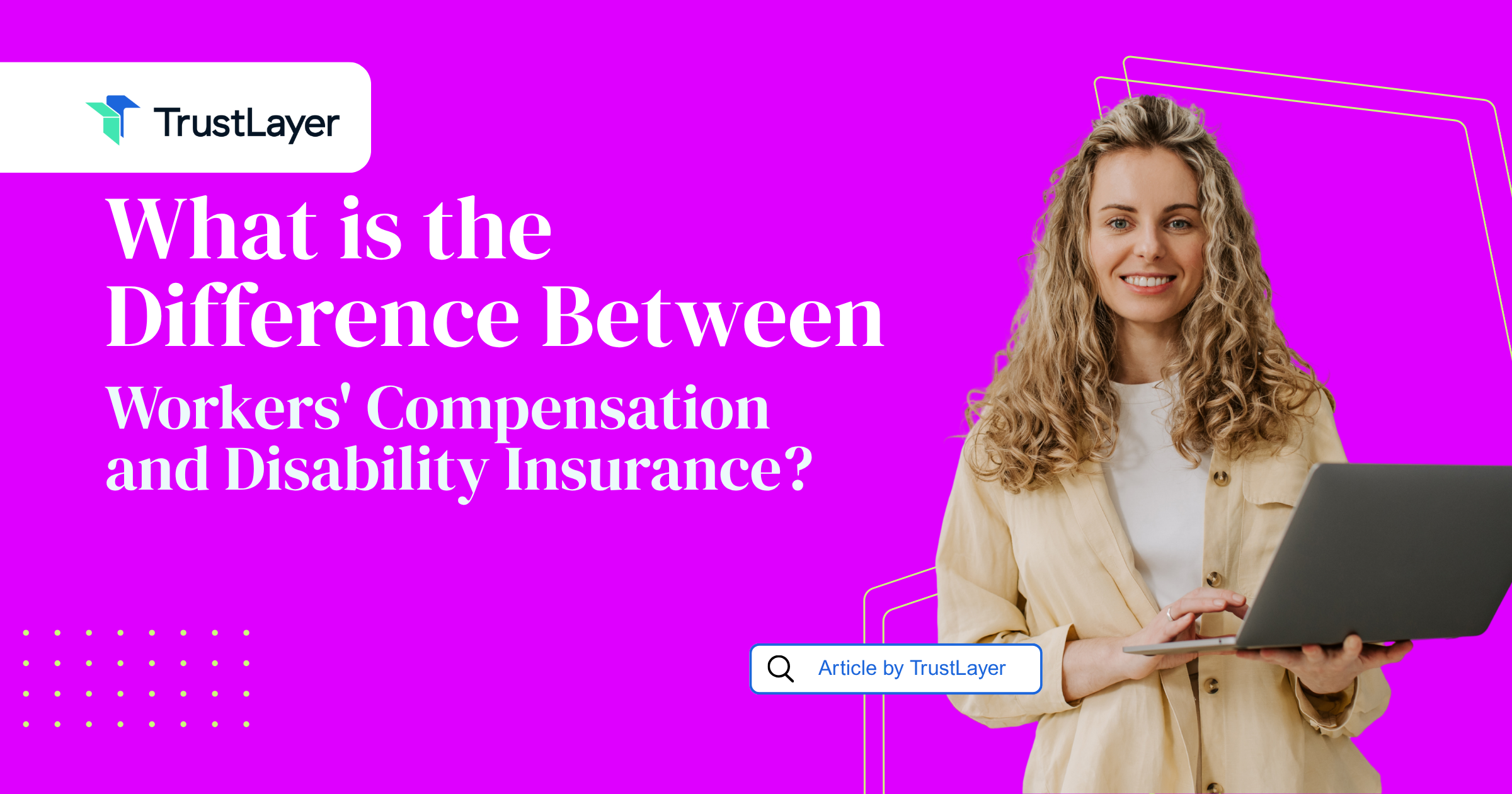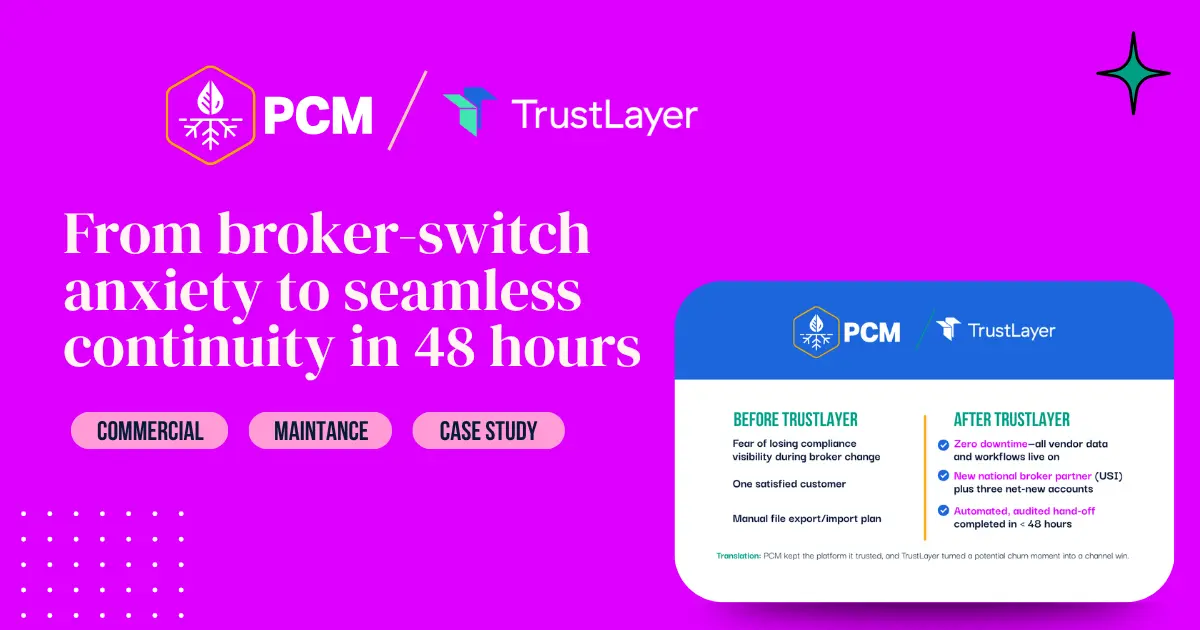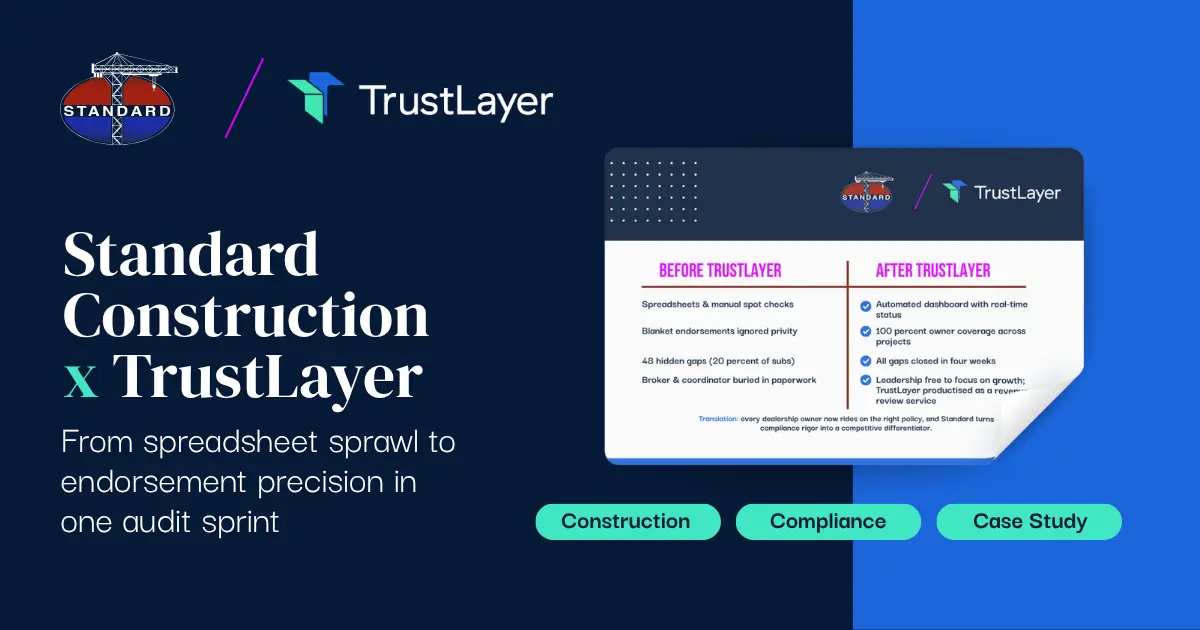What is the Difference Between Workers' Compensation and Disability Insurance?

When it comes to protecting employees and managing workplace risks, two types of insurance often come into the conversation: workers compensation and disability insurance. While they might seem similar at first glance—both provide financial support when an individual cannot work due to injury or illness—they serve distinct purposes and operate under different rules. Understanding these differences is crucial for employers, employees, and anyone navigating the complex world of workplace benefits.
This article delves into the nuances of workers' compensation and disability insurance, breaking down what each covers, how claims are processed, and why both are important in today’s workforce. Along the way, insights from licensed insurance professionals at TrustLayer will help clarify common misconceptions and guide you toward making informed decisions about workplace protection.
What Is Workers Compensation Insurance?
Workers compensation insurance is a state-mandated program designed to provide benefits to employees who suffer job-related injuries or illnesses. It’s a foundational part of workplace safety nets in the United States, with every state having its own specific laws and regulations governing coverage. This insurance not only protects employees but also shields employers from potential lawsuits related to workplace injuries, creating a balanced system that encourages safety and accountability in the workplace.
Coverage and Benefits
Workers compensation primarily covers injuries or illnesses that occur as a direct result of employment. This includes physical injuries from accidents on the job, repetitive stress injuries, occupational diseases, and even mental health conditions if they are work-related. The benefits typically include:
- Medical expenses: Coverage for hospital visits, surgeries, medications, physical therapy, and other necessary treatments.
- Wage replacement: Partial compensation for lost wages during the recovery period, usually a percentage of the employee’s average earnings.
- Rehabilitation services: Support for vocational rehabilitation or retraining if the injury prevents the employee from returning to their previous role.
- Death benefits: Compensation to dependents or beneficiaries if the injury results in the employee’s death.
It’s important to note that workers compensation benefits are typically paid regardless of fault. Even if the employee was partially responsible for the injury, they can still receive benefits under this system. This no-fault aspect is crucial, as it encourages employees to report injuries without fear of retribution or blame, fostering a culture of safety and transparency within organizations.
Who Is Covered?
Most employees are covered under workers compensation, though coverage specifics can vary by state and industry. Some states exempt certain types of workers, such as independent contractors or agricultural workers, from mandatory coverage. Employers are generally required to carry workers compensation insurance or self-insure to comply with state laws. Additionally, many states have specific provisions for high-risk industries, such as construction or manufacturing, where the likelihood of injury is significantly higher, ensuring that workers in these fields have robust protection.
How Claims Are Processed
When an employee is injured on the job, they must report the injury promptly to their employer. The employer then files a claim with their workers compensation insurance carrier. The insurer evaluates the claim and, if approved, begins paying benefits. The process emphasizes quick resolution to help employees return to work as soon as possible. However, employees need to understand their rights throughout this process, as they may need to provide documentation and medical evidence to support their claims. Moreover, in some cases, disputes may arise regarding the extent of the injury or the benefits owed, leading to a more complex claims process that may involve mediation or legal representation.
What Is Disability Insurance?
Disability insurance is a broader category of coverage that protects individuals against income loss due to disabilities caused by illness or injury, whether work-related or not. It’s designed to provide financial stability when a person is unable to perform their job or any job due to a disabling condition. This type of insurance is especially crucial in today's fast-paced world, where unexpected health issues can arise at any moment, potentially derailing one's financial plans and stability.
Types of Disability Insurance
Disability insurance generally comes in two main forms:
- Short-term disability (STD): Provides benefits for a limited period, typically up to six months, covering temporary disabilities.
- Long-term disability (LTD): Kicks in after short-term benefits end and can continue for years or until retirement age, depending on the policy.
These policies are often offered through employers as part of a benefits package, but individuals can also purchase private disability insurance for additional protection. It’s important to carefully evaluate the terms of each policy, as the specifics can vary significantly between different providers and plans. Understanding the nuances of coverage can help individuals make informed decisions about their financial safety net.
Coverage and Benefits
Unlike workers compensation, disability insurance covers disabilities regardless of their cause. This means that if an employee becomes disabled due to a non-work-related illness—such as cancer, heart disease, or a car accident—disability insurance can provide income replacement. Typical benefits include:
- Income replacement: Usually a percentage of the employee’s pre-disability earnings, often between 50% to 70%.
- Cost of living adjustments: Some policies include increases to benefits to keep pace with inflation.
- Rehabilitation support: Assistance in returning to work or retraining for a new role.
Disability insurance policies often have waiting periods before benefits begin, which can range from a few days to several months, depending on the plan. During this waiting period, individuals may need to rely on savings or other forms of insurance, making it essential to plan and understand the financial implications of a potential disability.
Who Is Covered?
Disability insurance coverage varies widely. Employer-sponsored plans may cover full-time employees, but part-time or contract workers might be excluded. Private disability insurance is available for anyone willing to pay premiums, often with underwriting requirements based on health status and occupation. Additionally, some policies may have specific exclusions for pre-existing conditions, which can affect coverage options for individuals with a history of health issues. Understanding these limitations is vital for anyone considering disability insurance, as it ensures that they select a policy that truly meets their needs.
Moreover, the importance of disability insurance extends beyond just the individual; it can also impact families and dependents who rely on the insured person's income. In many cases, having a robust disability insurance policy can provide peace of mind, knowing that financial obligations such as mortgage payments, education expenses, and daily living costs can still be met even in the face of unforeseen challenges. This safety net can significantly alleviate stress during difficult times, allowing individuals to focus on recovery and rehabilitation rather than financial burdens.
Key Differences Between Workers Compensation and Disability Insurance
Understanding the distinctions between these two types of insurance is crucial for both employees and employers. Here are the primary differences:
Cause of Disability
Workers compensation covers disabilities that arise strictly from work-related injuries or illnesses. Disability insurance, on the other hand, covers disabilities from any cause, whether related to work or not. This means that if an employee suffers from a chronic illness or is involved in a non-work-related accident, disability insurance would provide the necessary financial support, whereas workers compensation would not apply.
Coverage Scope and Benefits
Workers compensation includes medical care, wage replacement, rehabilitation, and death benefits specifically linked to workplace incidents. Disability insurance focuses primarily on income replacement and may include rehabilitation, but does not cover medical expenses. This distinction can be crucial for employees who may require ongoing medical treatment for a condition that is not work-related, as they would need to rely on their health insurance or personal savings in such cases.
Legal Framework
Workers compensation is governed by state laws, with mandatory coverage requirements for most employers. Disability insurance is often voluntary and regulated under federal and state insurance laws, with employer-sponsored plans subject to the Employee Retirement Income Security Act (ERISA). This regulatory framework means that the benefits and protections offered under disability insurance can vary significantly from one employer to another, making it essential for employees to thoroughly review their specific policy details.
Claim Process and Disputes
Workers compensation claims are typically handled through a state-administered system that can involve hearings and appeals if disputes arise. Disability insurance claims are processed by insurance companies, and disputes may be resolved through internal appeals or legal action. The complexity of these processes can vary greatly; for instance, workers compensation claims may require more documentation related to the workplace incident, while disability insurance claims might necessitate extensive medical records and evaluations to substantiate the claim.
Impact on Employment
Workers compensation benefits are tied to workplace injuries, and employers may have an interest in managing claims to reduce costs. Disability insurance is more focused on the employee’s overall health and ability to work, regardless of workplace factors. This can lead to a more supportive environment for employees dealing with long-term health issues, as they are not limited to just the context of their job. Furthermore, understanding these differences can empower employees to make informed decisions about their coverage needs and advocate for better policies within their workplaces.
Why Both Matter in Today’s Workforce
In an era where workplace safety, mental health, and chronic illnesses are increasingly recognized, having a clear understanding of both workers compensation and disability insurance is vital. Each serves a unique role in protecting workers and supporting employers in managing risks.
Addressing Workplace Injuries and Illnesses
Despite advances in safety, workplace injuries remain a significant concern. According to the U.S. Bureau of Labor Statistics, there were approximately 2.7 million nonfatal workplace injuries and illnesses reported by private industry employers in 2022. Workers compensation ensures that employees injured on the job receive timely medical care and wage replacement, reducing financial hardship and promoting recovery.
Supporting Non-Work-Related Disabilities
Chronic illnesses and disabilities unrelated to work are common and can severely impact an employee’s ability to maintain income. Disability insurance provides a safety net for these situations, helping employees stay financially afloat during difficult times. The Social Security Administration estimates that nearly one in four of today's 20-year-olds will become disabled before reaching retirement age, highlighting the importance of disability coverage.
Complementary Protection
Many employees benefit from having both types of coverage. Workers compensation protects against job-related risks, while disability insurance offers broader protection for life’s uncertainties. Employers who provide both demonstrate a commitment to comprehensive employee well-being, which can improve morale and retention.
Common Misconceptions and FAQs
Is Workers Compensation the Same as Disability Insurance?
No. Workers compensation is specific to work-related injuries and illnesses, while disability insurance covers disabilities from any cause.
Can I Receive Both Workers Compensation and Disability Benefits?
In some cases, yes. If a disability extends beyond the workers compensation benefits period, or if the injury leads to a non-work-related disability, an employee might qualify for disability insurance benefits as well.
Do Employers Have to Provide Both?
Workers compensation is mandatory in most states, but disability insurance is often optional. Some states, like California, mandate short-term disability insurance for employees.
What Is a Certificate of Insurance (COI) and Why Does It Matter?
A certificate of insurance (COI) is a document that verifies an insurance policy is in place. For employers, ensuring that contractors and vendors provide a COI for workers compensation or disability insurance helps manage risk and compliance.
How TrustLayer’s Licensed Insurance Professionals Can Help
Navigating the complexities of workers compensation and disability insurance can be challenging. TrustLayer’s licensed insurance professionals offer expert guidance to help businesses and individuals understand their coverage options, compliance requirements, and risk management strategies. Their expertise ensures that clients make informed decisions tailored to their unique circumstances.
Whether you’re an employer seeking to verify insurance certificates or an employee wanting clarity on your benefits, consulting with experienced professionals can provide peace of mind and protect your financial future.
Final Thoughts
Workers compensation and disability insurance are both critical components of a robust employee benefits strategy. While they overlap in providing income support during periods of disability, their coverage scopes, legal frameworks, and claim processes differ significantly. Understanding these distinctions empowers employees to advocate for their rights and employers to foster safer, more supportive workplaces.
For those interested in learning more about insurance topics, risk management, and workplace safety, be sure to explore other insightful articles from TrustLayer. Additionally, booking a consultation with TrustLayer’s licensed insurance experts can provide personalized advice and help you navigate the complexities of insurance with confidence.
As you navigate the complexities of workers compensation and disability insurance, the right tools can make all the difference. TrustLayer is at the forefront of modern risk management, offering a best-in-class certificate of insurance (COI) tracker that simplifies and automates the verification process. Our platform is designed to alleviate the administrative burden of document management, saving you time and money. If you're ready to embrace a forward-leaning approach to risk management and streamline your compliance workflows, set up a time to talk with our team and discover how TrustLayer can transform your business operations.
















